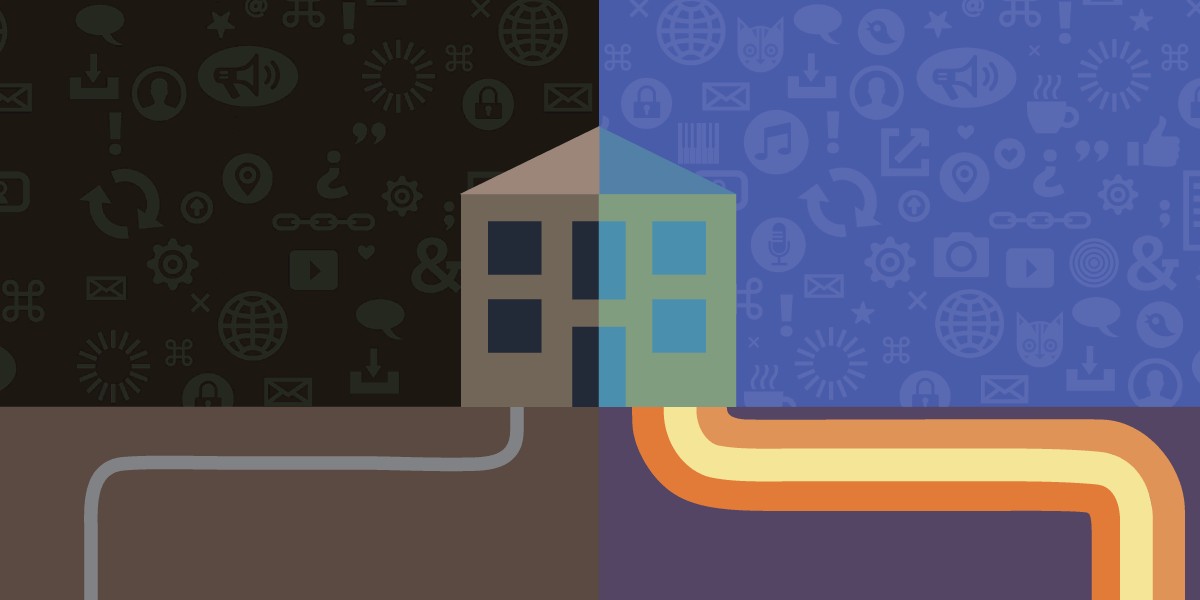A myth often pushed by incumbents who want to forestall universal fiber is that there is a high “cost” of fiber and cheaper alternatives. They’ll point to figures that for example show that a fiber-to-the home approach costs several thousands of dollars per household, when upgrading the copper DSL line or cable line can be done at a fraction of the price. They then use this argument for “cheaper” networks to advocate that government subsidies and public investments make a short-sighted focus on building networks with slow speeds, but broader coverage. But what they leave out is, despite the appearance of lower costs, they are in fact setting up these government programs for an exorbitant amount of waste—that translates into company profit— in the long run. If the government incentivizes building fast networks for the future, not just fast-enough for today, we will all save a lot of money over the long-term.
Slow Speed Networks Have Limits Hard Baked into Them Due to Physics
Cable and DSL networks, absent the investment in fiber optics, are not getting any faster and are deteriorating after decades of use. EFF has written this technical analysis explaining in great detail why this is the case. In short, the capacity of those wires to transmit data have real world limits whereas fiber optic wires have a capacity that our network technology has not even begun to reach. In cable and DSL networks, copper wires can only carry so much data over so much distance. Any significant improvements in the future will involve replacing big sections of the copper cables with fiber optics. But for pure fiber networks, the limit on capacity isn’t the cables, it’s the transmitters and receivers at each end. Once the fiber is in place, we’ll be able to upgrade these networks for years to come without having to bury any new cables. Because of the massive capacity differences, there is a “speed chasm” between legacy networks and fiber networks. and this plays directly into the true costs of choosing to incrementally upgrade an old network or switching over to all fiber.
To give you some real-world examples of the growing speed chasm between our two highest speed options in broadband we can look at the development of cable systems and fiber-to-the home, in the few places where Americans are lucky to have both. In 2015, Chatanooga’s EPB, the local government ISP, launched 10 gigabit download and upload networks whereas cable systems were able to transition towards gigabit download—but substantially slower upload—a little over a year ago. So, not only were the cable systems four years behind, they were also offering 1/10th of the speed., Butt here is the bigger issue that policymakers have to understand: it also costs EPB an exceedingly tiny amount of money to increase their network’s capacity ten-fold. All they had to do was switch out the networking hardware in their system when new devices were developed. We detail EPB’s financials below from their public reports when they transitioned to 10 gigabit networks, and the extra spending they needed to upgrade is practically invisible. In fact, the entire upgrade was 100% financed (with healthy profits) by affordable user-subscription fees with no price increases. Cable systems can not do this (and certainly not DSL).
The Number of Years a Wire Is Useful Is Directly Related to Its Cost
Let’s break this down with some numbers. If someone came to you and said you can spend $500 per household to give everyone 25 mbps/3 mbps—the woefully outdated federal definition of broadband—or you can spend $5,000 per household to give symmetrical gigabit (1000 mbps/1000 mbps), you may conclude that the first option saves you the most money, and the 25/3 offering is cheaper to build. You may think it’ll be easy to recover a $500 investment from subscribers, while a $5,000 per household seems daunting and too expensive. But you would be wrong, and here is why.
In any decision in building out a broadband network, we must also factor in its usefulness and capacity to handle the projected growth of consumption. For years without fail, data consumption has continued to rise as more applications and services require greater amounts of capacity. Cisco publishes these global trends with their annual reports. Check out the North American numbers below, and note that these projections did not account for COVID-19, which has only accelerated usage trends.
 These estimates reflect that an average household’s regular Internet usage in 2020 already exceeds 25 mbps on the download, and push way past 3 mbps on uploads with video conferencing alone. On average, people are going through 100s of gigabytes of data per month and that number will continue to increase.
These estimates reflect that an average household’s regular Internet usage in 2020 already exceeds 25 mbps on the download, and push way past 3 mbps on uploads with video conferencing alone. On average, people are going through 100s of gigabytes of data per month and that number will continue to increase.
So if you chose now, in 2020, to finance a broadband network delivering the federal standard of 25/3 as its top speed, you have already built an obsolete network that can not even keep up with normal usage of the Internet today. How many households could you get to recoup that $500 investment? The answer is zero, unless you have a monopoly. In places that have at least two choices for broadband Internet, market analysts are demonstrating that eventually no one will subscribe to DSL or advanced DSL networks, because they are not keeping up with consumption. That leaves the only real choices in broadband today as high-speed cable and fiber-to-the-home, for download purposes. The choices narrow even more if you’re prioritizing upload-based uses, like video conferencing. Only fiber-to-the-home works for this, until cable systems can be upgraded to be symmetrical. In essence, if you build a $500 connection giving a basic slow speed, no one would willfully pay for its use unless given no other choices. Furthermore, the network will eventually become so slow that it can’t even make use of the Internet—much like dialup today. In the end, you’ve spent $500 per household, with potentially no willing buyers. That’s a total loss.
Now, take the same scenario and apply the $5,000 fiber investment. If you are patient with the pace the infrastructure investment has to be recovered, you can space out how many years you are willing to wait to recover that $5,000. If you can wait ten years, it is around $42 per month plus interest. If you can wait twenty years, it is a little past $20 per month plus interest. The more years you add, the lower that monthly payment can be stretched—and you get to use the network at the same time. And you have a network that can not only service the needs of today, but also handle the level of demand needed for tomorrow and the distant future, with very little additional money needed to upgrade. It can also be utilized to simultaneously deliver 5G and a whole ecosystem of wireless companies as follow on users to help cover your costs.
When data consumption starts requiring 10 gigabit/10 gigabit connections, your same $5,000 investment remains useful, and in fact had that capacity ready five years ago. When average data consumption reaches 100 gigabit symmetrical or terabit symmetrical well into the future, your exact same network remains useful and ready for the challenge. You will still have willing buyers for its capacity because it remains relevant. And, given that broadband is an essential service that people will need their entire life, you will have a dedicated funding source. Even if it takes you 30 years to recover your costs, that still makes financial sense because fiber is expected to be useful for decades past those 30 years. That $5,000 cost can also be seen as a $10 per month for less than half of the asset’s usefulness, whereas a $500 cost in a slower speed will end being a $500 loss, and leaves you with a network that needs to be replaced by fiber anyway.
When Metrics Are Set Appropriately High, The Government Has Saved Money
North Dakota’s experience should be instructive for other state and federal policy makers. 60 percent of its households and businesses already have access to fiber to the home. An analysis by the consulting firm Conexon, which specializes in rural fiber by rural cooperatives, has found that while states across the country that received tens of millions of dollars from the federal government for broadband, almost all lack dense fiber networks—with the exception of a state like North Dakota.

Blue areas represent high-speed. Source: Broadband map based off Conexon analysis of government spending in broadband found at https://nationalunbroadbandmap.com/
How did that happen? How did nearly identical amounts of public investments in broadband yield such massive discrepancies? It boils down to the decisions the local governments and small private ISPs in North Dakota made with that government money. The federal government had extremely low expectations on how the subsidies should be spent, sometimes approving of projects as slow as 10 mbps/1 mbps. Companies like AT&T and Frontier spent those dollars to slightly improve services in their legacy copper networks on the cheap to reach those low numbers, rather than take it to discount a transition to fiber. Frontier ignored profitably opportunities to deploy fiber for so long that it is now undergoing bankruptcy due to its neglect.
Meanwhile, in North Dakota, the local government and small private ISPs made the decision to invest those federal government dollars, and their own local investments to match, into building out fiber networks. Now those networks are being paid off in the long run. And the local, state, and federal governments no longer need to come back and spend money to replace anything there. Those fiber networks will be able to offer symmetrical 10 gigabit services, 100 gigabit services, and terabit services well into the 21st century. And they will able to do so without government subsidies, but rather financed by typical monthly payments from users. Meanwhile, we’re going to have to spend another estimated $80 billion on the rest of the country that lacks fiber-to-the-home because we didn’t require fiber in the first place. In essence, every dollar the government has spent to assist ISPs to slightly increase their speeds has been a waste, given that those slow speeds are no longer relevant or useful to consumers—or are rapidly approaching the cliff. Those networks have hit their limits and only a replacement to fiber can yield further advancements. If policy required states to spend the billions the government provided on a transition to fiber 10 years ago, we would look more like South Korea today as opposed to being behind close to a dozen EU nations, the advanced Asia markets, and China. It’s time for us to catch up with the rest of the world, and invest in smart Internet infrastructure.












